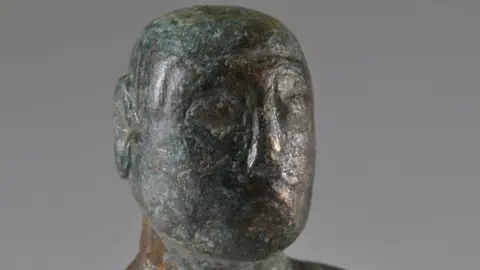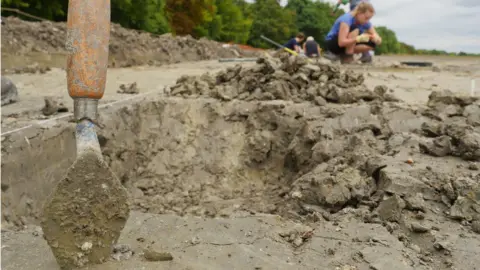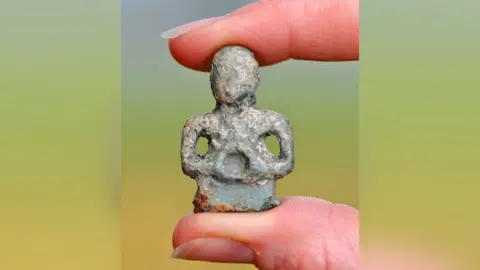Moustache on Wimpole Estate statue linked to '1st Century trends'
 NAtional trust/Oxford Achaeology
NAtional trust/Oxford AchaeologyA tiny statue's moustache and haircut could be evidence of popular fashion trends from the 1st Century, an archaeologist has said.
The 5cm (2in) figure of a Celtic deity was discovered at the National Trust's Wimpole Estate in Cambridgeshire.
Work in 2018 revealed a late Iron Age to early Roman rural settlement, and artefacts discovered there have since been subject to further analysis.
The "remarkable" detail was revealed when the figurine was cleaned.
 National Trust/Claire Sargent
National Trust/Claire SargentIts hair appears neatly shaped at the front and long but tidy at the back, and it is believed it could represent Cernunnos, the Celtic god of fertility.
Shannon Hogan, National Trust archaeologist for the East of England, said: "This figure is an exceptional find and thanks to careful conservation and cleaning, we can now see some remarkable detail.
"His hairstyle and moustache are clear, which might be indicative of current trends or perhaps typical for depictions of this particular deity."
While the figurine may have been made by the Romans, who invaded Britain in AD43 and settled, it exhibits "very Celtic traits" such as oval eyes, she added.
"The torc it is holding - an open-ended metal neck ring - is still clear and a small recess at the centre is suggestive of a decorative inlay, now lost," she said.
"We have extremely limited knowledge of what ordinary people of England at that time looked like, so this beautifully detailed figure might just be giving us a tantalising glimpse into their appearance, or how they imagined their gods."
 NAtional trust/Oxford Archaeology
NAtional trust/Oxford ArchaeologyThe figure probably originally served as the handle of a spatula, according to the National Trust.
It may have been lost or deposited at Wimpole by inhabitants of early Roman Britain at the end of the Iron Age.
'Influence and power'
Chris Thatcher, from Oxford East Archaeology, said: "Finds such as this give a rare and fascinating insight into aesthetics and symbolism in the latest Iron Age.
"The extent to which his hairstyle is typical of contemporary styles will never be known for certain.
"However, we think the combination of him holding a torc - associated with status - and forming the handle of a spatula - either used to mix medicines, or wax for writing tablets - speak of influence and power."
Imported pottery and about 300 metal objects were also uncovered during the dig.
These included coins, cosmetic implements, horse harness fittings, Roman military uniform fittings, a spearhead, an axe head, key handles and brooches.

Find BBC News: East of England on Facebook, Instagram and Twitter. If you have a story suggestion email eastofenglandnews@bbc.co.uk